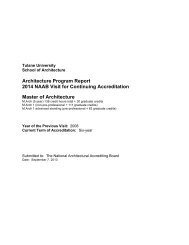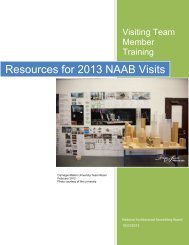Architecture Program Report Tulane University New Orleans ...
Architecture Program Report Tulane University New Orleans ...
Architecture Program Report Tulane University New Orleans ...
Create successful ePaper yourself
Turn your PDF publications into a flip-book with our unique Google optimized e-Paper software.
egistration and the mutual rights and responsibilities of interns and their<br />
employers.<br />
This material is covered in APFC 410, and is reinforced by seminars given<br />
by Professor Bruce Goodwin, our IDP liaison.<br />
32. Leadership<br />
Understanding of the need for architects to provide leadership in the<br />
building design and construction process and on issues of growth,<br />
development, and aesthetics in their communities.<br />
Due to Hurricane Katrina, this component of the criteria is now substantially<br />
reinforced. Several studios cover this material, some required (DSGN<br />
210/220; DSGN 310/320) and some elective. In particular the hands-on<br />
aspects of design/build projects have provided students with an overview of<br />
professional leadership. URBANbuild (DSGN 410/420), both on the<br />
microscale and macroscale reinforce this aspect of leadership in the design<br />
professions. Professor Coleman Coker deals with the issues specifically in<br />
his thesis course, DSGN 510/520. In addition, several elective courses,<br />
specifically those taught by Professors McNaughton and Rhodes deal with<br />
the issues surrounding leadership.<br />
Matters of leadership are also covered in both of the required Professional<br />
Concerns courses, APFC 410 and APFC 420.<br />
In addition, <strong>Architecture</strong> and Social Engagement (APFC 630) and<br />
<strong>Architecture</strong> and the Underserved (APFC 433) focus on matters of<br />
architectural leadership in the social sector.<br />
The requirement of a service learning component in every <strong>University</strong><br />
student’s curriculum explicitly reinforces the idea of leadership in the<br />
community, albeit in some cases broadly construed. But for those students<br />
in architecture, there is now a saturation of issues of leadership due to<br />
recent events in the city and the region.<br />
33. Legal Responsibilities<br />
Understanding of the architects' responsibility as determined by registration<br />
law, building codes and regulations, professional service contracts, zoning<br />
and subdivision ordinances, environmental regulation, historic<br />
preservation laws, and accessibility laws.<br />
This material is covered in the first of the required Professional Concerns<br />
courses, APFC 410. Another opportunity for understanding legal<br />
responsibilities occurs in the required elective APFC 620, a course entitled<br />
Legal Concerns of <strong>Architecture</strong>. Though an elective, approximately half the<br />
student body takes the course during their time in the School of<br />
<strong>Architecture</strong>.<br />
Students who take the PRST sequence are exposed to historic<br />
preservation and accessibility laws as well.














